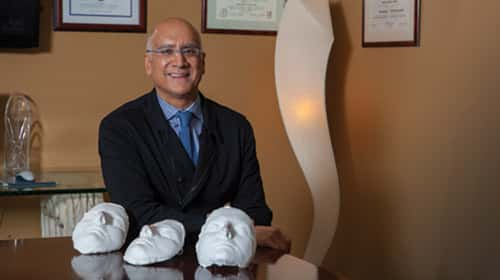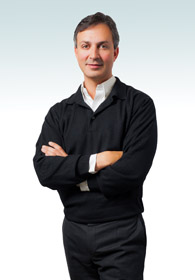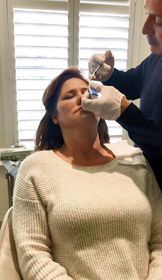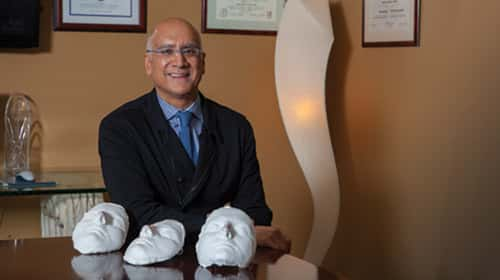Americans are seeking out cosmetic and plastic surgery services in greater numbers than ever before. Statistics compiled by the American Society of Plastic Surgeons reveal that between 2000 and 2016, surgically and minimally invasive cosmetic procedures increased by 132 percent in the United States. Approximately 17.2 million procedures were performed in 2016 alone, an increase of 4 percent over 2015.
It cost Americans more than $8 billion in 2016 to look good and, by extension, feel good from having plastic surgery. 

“Maybe it’s the ‘selfie’ world we live in now,” says Dr. Stanley Jacobs, director of the Jacobs Center for Cosmetic Surgery in Healdsburg. “And as the economy has improved, I have patients asking for more than one procedure. Instead of wanting only a facelift, they want the facelift and something else, too, because they feel better about themselves and are better able to afford it.”
“Plastic” surgery refers to making shape changes to the face and body (not using actual plastic), and “cosmetic” surgery is defined as non-essential, elective procedures to improve one’s appearance. Female patients outnumber men by a significant margin, perhaps because society places added pressure on women to defy aging. Jacobs says patients in his practice are primarily female; about 15 percent are male. “A few years ago the percentage of male patients in my practice was only in the single digits.”
Becoming “age neutral” is important for many people who wish to put their best face forward, literally. “The concept of age neutral, is meant to denote that if we take care of ourselves and/or if we have cosmetic procedures, that we don’t appear to age harshly or quickly,” says Jacobs. “We always want a natural look. So others never think you have had any work done. Part of this is eating well, exercising, not smoking, minimal alcohol and if you elect to have cosmetic procedures, that they’re performed in such a way as to appear very natural, balanced and harmonious,” he says. “I call that finesse surgery.”
Avoiding the scalpel
Fear of the scalpel, however, brings many patients to North Bay plastic surgery practices in search of non-surgical methods. “There can always be non-surgical treatments versus surgical,” explains Dr. Gregory Chernoff, owner of Chernoff Cosmetic Surgery in Santa Rosa. For instance, fillers and injections are administered using fine needles for many specific purposes––to eliminate wrinkles, reduce the double chin effect, or smooth away acne scars and other skin imperfections.
“Looking your best plays a direct role in business success, and lots of women and men of a certain age tell me they don’t want their appearance to be an issue,” adds Chernoff. Twenty years ago his clientele was 90 percent women; today it’s more evenly divided between women and men.
People consult with him for three primary reasons: “First, for the gravitational descent of their muscles. Their eyebrows and forehead begin to fall, and there may be hooding around the eyes, and also jowling. Second, they’ve lost fat around their mouths and are losing bulk and definition. Third, they’ve lost skin elasticity and tone. Those three reasons apply to both above the neck and below.”
In Chernoff’s practice, the most common non-surgical treatment is Botox injections to smooth unwanted lines such as crow’s feet. Though it’s a toxin, Botox has many safe medical uses, including helping to reduce wrinkles on the face.
“Over the past decade there’s been a rise in the number of non-invasive procedures,” explains Dr. Victor Lacombe of Artemedica in Santa Rosa, a plastic surgery practice. “There’s a greater demand from the patient side for non-surgical methods, because they want to avoid any down time. They want to go right back to work and back out into public. Fortunately, injectables and new devices we use in our practice are much better than they used to be, even since five years ago.”
Injectables and Millennials
Surgical and non-invasive procedures are gaining more acceptance among men, Lacombe says, but Millennials of both genders are embracing them, too. Injectables, in particular, appeal to younger people, who tend to be more spontaneous, he adds. “It’s the Millennial mindset of me-centered experiences. With so much social media presence, many of them take their own photograph several times a day, and they can’t take the time to Photoshop each one. We call the work we do with injectables ‘Photoshop you can walk around with.’”

There’s an alphabet soup of injectable formulas that target specific areas of the face and neck, with names such as Bellafill and Radiesse. Chernoff also offers a radio frequency microneedle treatment for rejuvenating skin, improving skin tone, and even reducing stretch marks. His practice’s three most popular procedures are Botox injections for unwanted lines and crow’s feet, injectable fillers to improve areas around the mouth and jawline, and the radio frequency microneedling. That procedure delivers heat to deep dermis and sub-dermal skin layers to build and strengthen collagen without damaging the outer layers of skin.
About 90 percent of Chernoff’s job, he says, is managing patients’ expectations before and after their procedures. “We listen to what clients want to improve, and make certain they are coming to us for the right reasons and to boost their self-esteem. I like to pretend there are 10 other doctors in the room to get a majority vote to make a good decision for each client. The treatment they choose may not get them a better job, but it will help their confidence.”
Patients in his practice range from 18 to 90 years old, he says, with many younger people wanting to begin a long-term plan of procedures.
The right reasons
Jacobs says it’s essential to interview potential clients thoroughly to make certain they want a procedure for themselves, not for others. “We don’t like to hear, ‘My boyfriend wants me to get this,’ or ‘My husband wants me to fix that,’ or ‘I want to win back my husband who is divorcing me.’ Those are not good reasons to undergo plastic surgery.”
Several young female patients recently consulted with Jacobs about undergoing rhinoplasty. “In my opinion they looked great, but one said her boyfriend complained that her nose just didn’t seem right. I told them to go home and forget about fixing something that doesn’t need fixing. They are usually relieved to hear that, almost like a load has been lifted off their shoulders.”
go home and forget about fixing something that doesn’t need fixing. They are usually relieved to hear that, almost like a load has been lifted off their shoulders.”
 go home and forget about fixing something that doesn’t need fixing. They are usually relieved to hear that, almost like a load has been lifted off their shoulders.”
go home and forget about fixing something that doesn’t need fixing. They are usually relieved to hear that, almost like a load has been lifted off their shoulders.”Other clients sometimes ask to have a procedure that will result in only a subtle change to their appearance. “So we encourage them to wait and come back in a couple of years, when the time might be more ideal for the procedure,” says Jacobs. “We have to be honest and sensitive to patient needs, and we also want to do what’s right.”
Though some of the minimally invasive procedures offered by Lacombe’s practice are aimed at younger people, “mommy makeovers” such as tummy tucks, breast lifts and facelifts for older patients are still popular. “That part of our practice hasn’t changed. People want to be viable in the job market, because many are working longer in their careers and want to look good doing it.”
Projecting energy and vitality
Businesspeople are on camera more than ever before, says Jacobs, producing videos and videoconferencing as part of their professions. “An inventor who came to see me needed to make videos to sell his products and wanted to get rid of his frown lines and look more relaxed and youthful. I also know professors who travel for public speaking and they also make videos. They don’t want to look old. They want to project energy.”
Jacobs recently treated a male patient in his 50s who had been let go from his job. “His neck was loose and he had baggy eyelids, so we performed a facelift. He eventually interviewed for a new job and was hired. The new employer had no idea he’d had work done. He kept the wisdom he’d gained with age and experience, but left behind the wrinkles.”
Jacobs calls himself the “anti-filler” physician. “Fillers are not for everyone. Injectables appeal to many people who are surgery-phobic. But our job is to educate, to make them aware of the pros and cons of each technique and to do what is best for them.”
The Jacobs Center is one of the few practices in the nation offering the Cutometer, a device that measures the visco-elasticity of skin. “It’s been shown that even people with very poor skin that is sun damaged and saggy can regenerate new collagen and elastin. Some of my patients over 70 feel there is no hope for their skin, but we can perform chemical peels that achieve a 40 to 50 percent increase in skin elasticity,” says Jacobs.
Whether we like it or not, says Lacombe, others judge us by our appearance. “Because of droopiness in the face, a person can look sad or angry without even meaning to. Others can perceive you as tired. Even if you weigh the same now as you did in college, your face can still show your age. Those ‘marionette’ lines from the corners of your mouth to your chin also telegraph ‘anger.’ But with some subtle treatments it’s possible to look better and improve your attitude. I see this time and time again in my patients. Following treatment, they become much more confident and happier.”
Body contouring
Lacombe’s practice offers coolsculpting, a non-surgical method of body contouring that eliminates fat cells in targeted areas by as much as 20 percent. Coolsculpting is popular with both women and men, he says; in fact, about 30 percent of his coolsculpting clients are men. “There’s not as much of a stigma for men to have this procedure. They want to get rid of their spare tires and potbellies. With the other procedures offered in my practice, only about 15 percent of clients are men.”
Chernoff believes the success of non-surgical fat reduction methods are limited, however. “Nobody likes the word ‘surgery,’ so some people undergo a non-surgical treatment, but then don’t see results. Patients who went elsewhere have come to me for second opinions. In some cases, they had a procedure I wouldn’t have recommended to them in the first place.”
A 45-year-old businesswoman in Santa Rosa who asked to remain anonymous underwent coolsculpting about five years ago, then again within the past year. “Denise” knew several friends in her age group who’d had coolsculpting, and it sounded like a good fit for her. “Certain problem areas I couldn’t fix by exercising and going to the gym,” she says. “One was my belly. The procedure took about three hours to treat both my belly and an area near my breasts. As a result, my belly got much flatter.”
Computer Imaging
Chernoff uses computer imaging to show a prospective patient what is realistically possible. “But if a patient insists on more and more surgeries, that’s not a good patient for me. We have identified patients in the past who we referred to psychologists so they could get the guidance they needed.” A rare condition called body dysmorphic disorder (BDD) afflicts a very small percentage of plastic surgery patients who become obsessed with what they see as defects in their bodies and faces, even after multiple procedures.
obsessed with what they see as defects in their bodies and faces, even after multiple procedures.
 obsessed with what they see as defects in their bodies and faces, even after multiple procedures.
obsessed with what they see as defects in their bodies and faces, even after multiple procedures.“We do have to be careful of patients who ask for surgery again and again,” says Jacobs. “They undergo surgery A, then come back for B, then they want C, and so on. We are sensitive to their addiction and try to get them help for it when it becomes necessary.”
Most prospective patients who visit plastic and cosmetic surgeons in the North Bay for a consultation are primarily hoping to restore how they once looked, or stop wrinkles before they get established. “This isn’t Los Angeles, where there is more extremism,” says Lacombe. “People here want to take a few years off their appearance. They don’t want to look like a Kardashian. It’s my job to listen to their goals, whether they are realistic or not, and to establish trust.”
The Delicate Art of Tattoo Removal
One thing is certain about tattoos: it’s more costly and a bit more uncomfortable to have one removed than it was to have it applied in the first place. But if you regret getting that Grateful Dead logo on your forearm, or pledging your love to someone who no longer has a special place in your heart—but whose name is still emblazoned on your shoulder—it’s possible to make them go away for good.
Tattoo removal as performed by Dr. Vincent Lacombe at Artemedica in Santa Rosa involves multiple treatments, usually four to six weeks apart, using VersaPulse lasers to break up the inks. Depending on the colors and size of the tattoo, and the depth of the inks used, it can take a year or more to remove a tattoo successfully. “Sometimes only eight to 10 treatments are needed, but new and dark-colored tattoos can take as many as 20 to 25 treatments,” says Lacombe.
There are many reasons for wanting to remove tattoos. For instance, anyone wishing to join the military is forbidden to sport a tattoo visible above the collar, says Lacombe. Perhaps you seek a job in an industry that frowns on tattoos, or you long ago outgrew a youthful message projecting from your epidermis.
New parents can also have tattoo regret. “When young people with big tattoos start having families, they want to set an example for their children,” says Lacombe. “And at some point they don’t want their toddler asking, ‘Daddy, what is that?’”
“It was one of the best investments I’ve ever made,” states Santa Rosa-based plastic surgery patient “Pete” (not his real name), about undergoing a full facelift in July 2017 at the Jacobs Center in Healdsburg. The 64-year-old gaming executive was motivated to improve his appearance because he didn’t like the face he saw in the mirror.
Lift the Face, Lift the Spirit
“I was looking haggard and burned out. I had a double chin and my face was sagging,” he recalls. “I’m in good shape, but my body looked 40, and my face looked 60. And you’re at a competitive disadvantage in business when you are seen as the old guy in a room full of people in their 20s and 30s.”
In his line of work, Pete attends boardroom meetings with other high-powered executives, and also does a lot of public speaking in front of large groups. “Before the surgery, I heard from others that I looked ‘tired.’ Much of your success in business is based on perceived vitality, but when your face is drooping, that perception changes. If you want to stay in the game, you need to project energy and vitality. That’s the world we live in, unfortunately.”
Last year, Pete accompanied a friend to her appointment with Dr. Stanley Jacobs and became convinced he was ready to undergo a procedure, as well. “If it’s something that makes me feel better about myself and gives me self-confidence, why not? I’m trying to change the paradigm about men having these kinds of procedures, because there is still a stigma.”
Pete’s surgery was completed in a single, four-hour visit with Dr. Jacobs. “There was nothing unpleasant about it,” he explains. “After I returned to work, I heard remarks like, ‘You look rested,’ and “Did you lose weight?’”
Deciding to undergo cosmetic or plastic surgery ultimately comes down to how you feel inside, he says. “Don’t worry what other people think. If your appearance bothers you, do something about it. I plan to live a long time and want all the technology that’s out there to help make my life better and longer. Since the facelift, I tell friends that I’ve had my 100,000-mile tune-up and I’m good for another 20 years.”
Author
-

Jean Doppenberg is a lifelong journalist and the author of three guidebooks to Wine Country.
View all posts




